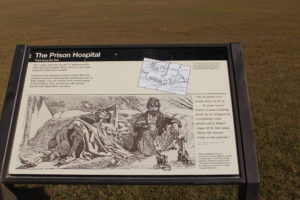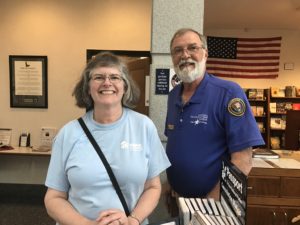
Andersonville National Historic Site is, like most of the Civil War sites, a difficult place to visit. I have a difficult time understanding people who are willing to kill their fellow citizens instead of changing their way of life. I probably would have been a Loyalist in the Revolutionary War, asking “why can’t we all just get along?”
Andersonville highlights some of the worst behavior of one side in war toward the other. Unfortunately, that story is not told at the Historic Site. Because the Historic Site is in the south, the museum tells a geographically cleansed story of the fate of all prisoners of war. Tom and I wandered around the museum for a while. We saw displays on conditions of POWs in the Revolutionary War, Civil War, World War I and II, Korean War, and Vietnam War. The section on POW conditions in the Civil War talked about the positions of all the Prisoner of War Camps but didn’t go into any detail about Andersonville.
I think this is unfortunate. Each place has a story to tell, and that story can teach us. There were similar atrocities at Civil War prison camps in the north. But Andersonville was one of the largest and most deadly Civil War camps and it should be a moral lesson for us. Instead, the story becomes useless when it is too watered down. There weren’t enough details about anything to teach us a lesson.
 Andersonville National Historic Site has three features: the National Prisoner of War Museum, the Prison Site, and Andersonville National Cemetery. After we looked at the museum, we wandered the grounds of the prison. The prison was 26 1/2 acres of sloping ground with a creek running through the middle. A stockade 15 feet tall surrounded this large field. The creek was the only source of drinking water for the prisoners. Up to 33,000 men lived in this field at one time and almost 30% died from disease or starvation. Some of the stockade wall is rebuilt and a small section is set up as if Union POWs were living there.
Andersonville National Historic Site has three features: the National Prisoner of War Museum, the Prison Site, and Andersonville National Cemetery. After we looked at the museum, we wandered the grounds of the prison. The prison was 26 1/2 acres of sloping ground with a creek running through the middle. A stockade 15 feet tall surrounded this large field. The creek was the only source of drinking water for the prisoners. Up to 33,000 men lived in this field at one time and almost 30% died from disease or starvation. Some of the stockade wall is rebuilt and a small section is set up as if Union POWs were living there.
We checked out the Star Fort and the site of one of the prison hospitals. There wasn’t any medicine to treat men who were sick or bandages for wounds so those who went to the hospital generally didn’t return. Men survived if they had a network of friends who looked out for them.

We did not have time to see the movies. There are two movies, one on Andersonville and the other on Prisoners of War. We also did not have time to visit the cemetery. However, we did run into five people we had met before. The volunteer at the Visitor Center desk is the father of one of the rangers we worked with at Chickamauga. We met him when he visited his son. Tom and I also ran into a family that had been at Frederica the previous week. We remembered them because the children had so many Jr. Ranger badges. They were doing the Jr. Ranger program at Andersonville as well.

Andersonville National Historic Site is an interesting place to visit. In order to understand more about the prison, you need to get out and walk around the site. A visit to this site is a good reminder of the high and tragic cost of war.
